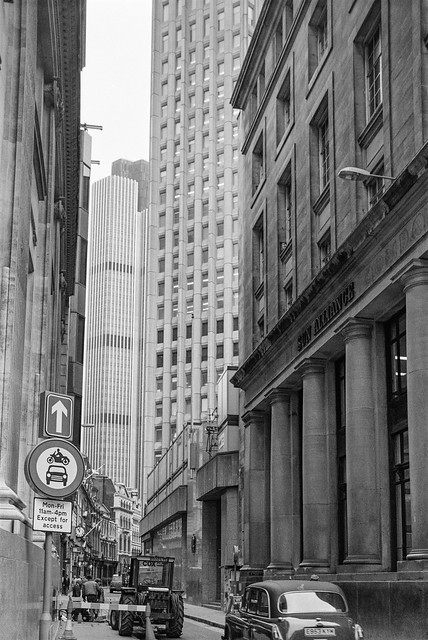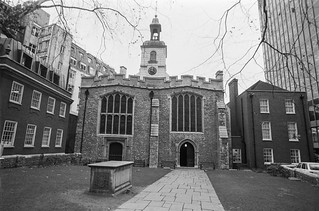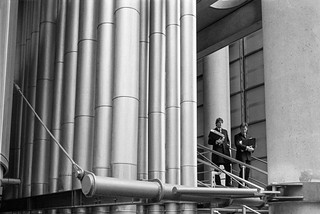The view from the west end of Throgmorton St has changed a little since 1987 but is still recognisable. Largely Victorian or Edwardian at ground level, but dominated vertically by the two towers, both technically on Old Broad Street, though the right hand one, then the Stock Exchange, had an entrance and a long frontage on Throgmorton St.
The London Stock Exchange has a long history from its origins at Jonathan’s Coffee House in Change Alley (though presumably it only got that name later) in 1698. Even older was Stock’s Market, which the City of London plaque at Mansion House dates from 1282-1737, but despite that plaque being featured on the Stock Exchange web site, that was a food market which got its name from the wooden stocks where miscreants would have their legs locked and be subjected to insults and pelted with rotten food, stones and anything else that came to hand. Unfortunately despite being a hotbed of criminal activity there are no stocks at the modern stock exchange.
In 1972 the Stock Exchange moved from Capel Court where it had been since 1802 to a new building, the Stock Exchange Tower, at 125 Old Broad Street. This building with a squashed hexagonal floor plan had a long frontage on Throgmorton St and was 100m high with 26 floors. The Stock Exchange moved out to Paternoster Square in 2004, but the building is still standing, though in disguise, its concrete now hidden behind a glass wall, and with some added office space in new building at the side.
Also still in place, though a little altered is the Nat West Tower, between Old Broad St and Bishopsgate, and in 1987 there was a highwalk underneath it that led to a pedestrian bridge crossing Bishopsgate.
The Natwest Tower, completed in 1980, was 183 metres tall, and was the talllest building in the UK until the Canary Wharf Tower was completed in 1990. It remained the tallest building in the City until 2009. It required extensive refurbishment over several years after being damaged by the IRA Bishopsgate bomb in 1993. Natwest moved elsewhere and in 1995 it was renamed Tower 42, referencing the 42 floors cantilevered out above its base. The highwalk was not replaced after the bombing.
Although these walkways were open to the public, they were private property and although I photographed from them on several occasions, apparently photography was not allowed. On one occasion after taking some pictures I was approached by a very apologetic security manager in a suit and tie, who told me that photography was not allowed, before walking with me to the line on the pavement marking the the boundary to the property and inviting me to continue taking pictures from there.
I think this was the door to a bank, and I’m sure it was on Bishopsgate or possibly its southern continuation, Gracechurch St. I’ve walked along there a few times in recent years and I think both the door and the building it was on have been replaced.
The bridge across Bishopsgate had steps down in front of an office building on the corner of Bishopsgate and Great St Helen’s, a short street leading to the church of St Helen’s Bishopsgate. This is really two churches and is one of the few churches in the City to have escaped destruction both in the 1666 Great Fire and the Blitz. The church (at left) was there before 1210 when permission was given to build a Benedictine nunnery at its right, the two parts almost but not quite indentical.
Interesting stories are told about some of the things the nuns and priests at times got up to, but it was more the marital activities of Henry VIII that led to him declaring himself head of the Church of England in 1536, following which this and other nunneries were dissolved with the wall dividing the two parts being removed in 1538. There have of course been various alterations since then, particularly in the Victorian era, and it required restoration after being damaged by IRA bombing nearby in 1992-3 providing an opportunity to reverse some of those Victorian changes.
Walking past the St Helen’s Bishopsgate leads to Undershaft, St Mary Axe and Leadenhall St, though much of the area that was back then open is now occupied by giant towers which hide the Lloyds Building until you are rather closer. Even back in 1987 it was a building I felt I’d photographed too much – though even now it’s difficult to resist yet another picture. But perhaps this one was just a little different.
More on page 7 of my album 1987 London Photos.
All photographs on this and my other sites, unless otherwise stated, are taken by and copyright of Peter Marshall, and are available for reproduction or can be bought as prints.
Tags: 1987, Bishopsgate, Great St Helens, Lloyds, London, Nat West Tower, St Helen's, stock exchange, Throgmorton St, Tower 45






